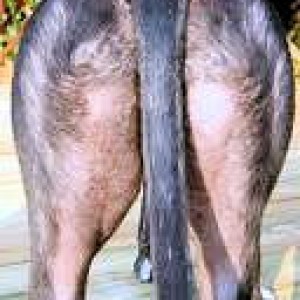 Greyhounds are generally healthy hounds, but it does seem that alopecia (hair loss) is a fairly common condition in a number of ex-racers. While it can occur in various regions around the body — belly, chest, neck, thighs, behind the ears — it most commonly affects the backsides of the hind legs, where it is known as bald thigh syndrome (BTS). It also appears to be more prevalent in the darker-coated dogs.
Greyhounds are generally healthy hounds, but it does seem that alopecia (hair loss) is a fairly common condition in a number of ex-racers. While it can occur in various regions around the body — belly, chest, neck, thighs, behind the ears — it most commonly affects the backsides of the hind legs, where it is known as bald thigh syndrome (BTS). It also appears to be more prevalent in the darker-coated dogs.
Greyhounds with BTS have a history of normal hair distribution when first brought into work at the track, but, about 4 weeks after entering a full training program, there is a progressive loss of hair at the back and side of each thigh with increased discoloration of the skin (hyper-pigmentation). The Greyhound shows no sign of illness, and there is no inflammation, irritation or abrasion of the skin surface. Greyhounds of any age, male or female, may be affected.
There are numerous opinions on possible causes for this type of baldness. While originally felt to be the result of the dog rubbing against the sides of its crate, currently it is most thought to be of a metabolic nature — the over-production of cortisol (a hormone produced by the adrenal gland of the body) induced by the rigors of a racing / training program. While most cases clear themselves up within 6 to 8 months of retirement, some Greyhounds maintain their bald thighs the remainder of their lives.
 Since it is pretty much limited to the Greyhound breed, BTS is not well recognized in the veterinary profession. Misdiagnosis of it and some of the other benign types of skin abnormalities in Greyhounds (such as comedones / blackheads) accounts for a great deal of unnecessary, expensive, and invasive procedures — and needless worry for adopters. For one thing, bald thigh syndrome is NOT linked to hypothyroidism, and your Greyhound should NOT be supplemented with thyroid medicines on the basis of its hairless thighs alone.
Since it is pretty much limited to the Greyhound breed, BTS is not well recognized in the veterinary profession. Misdiagnosis of it and some of the other benign types of skin abnormalities in Greyhounds (such as comedones / blackheads) accounts for a great deal of unnecessary, expensive, and invasive procedures — and needless worry for adopters. For one thing, bald thigh syndrome is NOT linked to hypothyroidism, and your Greyhound should NOT be supplemented with thyroid medicines on the basis of its hairless thighs alone.
While there is no known cure for this condition, a search for BTS in various Greyhound forums on the Internet will produce a number of topical “treatments” that owners have sometimes felt to be of benefit in encouraging the re-growth of hair.
CONCLUSION: Similar to “male pattern baldness” in humans, bald thigh syndrome (BTS) is purely a cosmetic condition and doesn’t affect the health of the Greyhound in any way. In fact, Greyhound owners often find this unique characteristic in their hounds to be endearing and even celebrate it at Greyhound events with “Shiny Hiney” and “Baldest Butt” contests.
